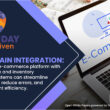Absolutely, leveraging data analytics in B2B e-commerce can provide valuable insights that drive informed decision-making and enhance overall business performance. Here’s a breakdown of how you can utilize analytics and data insights in the B2B e-commerce space:
- Customer Behavior Analysis:
- Segmentation: Analyze customer data to segment your B2B customers based on various criteria such as industry, company size, location, purchasing frequency, etc. This helps tailor marketing efforts and offerings.
- User Journey Analysis: Track the customer journey from initial interaction to purchase, identifying drop-off points and optimizing the user experience.
- RFM Analysis: Utilize Recency, Frequency, and Monetary value analysis to categorize customers based on their purchasing behavior and target them accordingly.
- Sales Patterns and Trends:
- Demand Forecasting: Analyze historical sales data to predict future demand for products, optimizing inventory management and reducing overstock or stockouts.
- Cross-Selling and Upselling: Identify product affinities and suggest complementary or higher-tier products to customers, increasing average order value.
- Seasonality Analysis: Recognize seasonal trends to adjust marketing efforts, promotions, and inventory levels accordingly.
- Platform Performance Insights:
- Website Analytics: Monitor website traffic, user engagement, bounce rates, and conversion rates to identify areas for improvement in the online shopping experience.
- Page Performance: Analyze load times and user interactions on specific pages to optimize site speed and functionality.
- Checkout Funnel Analysis: Identify points of friction in the checkout process that may be causing abandoned carts and take steps to optimize the process.
- Personalization and Customization:
- Recommendation Engines: Implement recommendation algorithms that suggest products based on a customer’s browsing and purchase history, increasing the likelihood of conversion.
- Personalized Content: Tailor marketing campaigns, email communication, and website content to individual customer preferences and behavior.
- Supply Chain Optimization:
- Supplier Performance: Analyze supplier data to assess lead times, quality, and costs, aiding in supplier selection and negotiation.
- Logistics Analysis: Optimize shipping routes and methods based on historical data to reduce shipping costs and delivery times.
- Competitive Analysis:
- Market Trends: Monitor competitor pricing, product offerings, and promotions to make informed pricing and marketing decisions.
- SWOT Analysis: Evaluate your strengths, weaknesses, opportunities, and threats based on data insights to develop a competitive strategy.
- Predictive Analytics:
- Churn Prediction: Identify customers at risk of churning based on their behavior patterns, enabling proactive retention strategies.
- Sales Predictions: Forecast future sales based on historical data, enabling effective resource allocation and goal setting.
Remember, the success of your data-driven approach relies on data accuracy, proper tools, and skilled analysts. Regularly reviewing and refining your analytics strategy is essential to adapt to changing market dynamics and customer behavior in the B2B e-commerce landscape.


